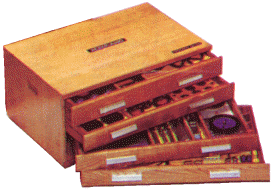Description of a 197O's Meccano set 10 Cabinet.
| Paul Dale provided this description
of a mid 70s Binns Road set cabinet. It is four drawer with the 'L' shaped aluminium
handles and has a "teak" finish . The box is 607mm wide, 278mm high and 400mm deep. The top and bottom
overhang the drawers so that they are flush. Likewise, the fronts of the drawers are
flush with the sides of the box. There are two cut-out hand-holds which he didn't
measure, one in each side. They are produced by cutting 1-ply out of the
sides. The box also has four rubber feet underneath, which earlier cabinets did not
have.
|

|
| The upper three drawers aren't as deep as the
bottom one. The upper three are 579mm wide and 332mm deep.
The bottom of the four drawers is 579mm wide and 357mm deep The height varies between the drawers and are listed for each drawer below. The
outer four sides are made of 11mm 5-ply and the interior partitions are 8mm 3-ply. The
front of the drawer has a facing attached that is the full width of the box, 8mm thick
with a beveled front top edge. Each drawer has a slot down each side (located
centrally) that let it slide on runners fixed to the outer box. The base of each
drawer is ply wood 1-ply 3mm thick. The handles are 102mm wide and are situated
94mm from the edge of the front of the draw.
|
 |
The top drawer, illustrated at left, is 63mm high and
contains three compartments running the full depth of the drawer. These are 171mm,
100mm and 266mm wide, from left to right. These widths are the spaces between the
interior separators.
|

|
The second drawer has three compartments: 165mm, 177mm and
195mm wide, from left to right. This drawer is 50mm high. |

|
The next drawer down has four compartments: 232mm, 126mm,
48mm and 122mm wide, from left to right. This drawer is also 50mm high.
|

|
The bottom drawer has two triangular sections, back left
and front right corners and three diagonal sections running from the front left corner to
the back right. For this drawer only, the internal partitions are cut down from the
3-ply to 1-ply where they intersect the outside edge. Below are the measurements for
each of the outer sides. These measurements are between the partitions / from the
corner to the first partition. All four of the diagonal separators are parallel.
This drawer is 48mm high.
|
Replica decals, suitable for
restoring motors or rebuilding cabinets can be obtained from:
Frizinghall Model Railways (UK) |
|
left: from back 250mm, 55mm, 40mm to front
right: from back 42mm, 55mm, 250mm to front
back: from left 430mm, 97mm, 19mm to right
front: from left 20mm, 92mm, 424mm to right
|
The dimensions of this aluminium-handled cabinet vary slightly
from the cabinets of the early 1970s, which had little white knobs. The
overall dimensions of the two are as follows:
| Cabinet |
Width |
Height |
Depth |
Early 1970s "Oak"
with white knobs |
597mm |
285mm |
368mm |
Late 1970s "Teak"
with aluminium handles |
607mm |
278mm |
400mm |
All unpainted woods will release acidic
gases, particularly acetic acid, as they age. Oak is one of the worst. Paul
can confirm that the box rusts the zinc pieces most effectively, usually leaving the white
powdery residue (zinc carbonate). At least three thick coats of polyurethane would
be needed to seal the wood.
Roland Jaggard has provided excellent
photographs of a
late 1950s Set Ten which shows
all the stringing cards that were used by the factory to display the set. These
cards were usually discarded by the owners, so it is rare to find a set with these cards
retained!
Currently there are two
manufacturers of replica cabinets
Frizinghall Model Railways (UK)
Ashok
K. Banerjee (India)




